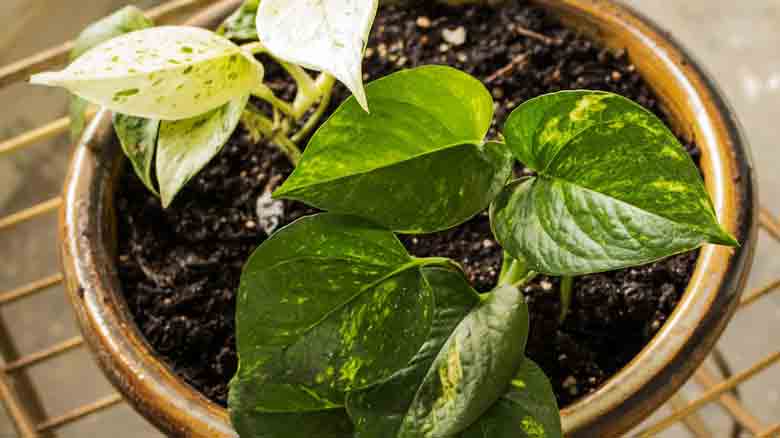The pothos is a great option if you’re looking for an easy-to-care-for houseplant.
This plant is tolerant of a variety of conditions and can thrive in both low and high light environments.
They are some of the easiest plants to care for, and they add a touch of greenery to any room.
But do pothos like to be misted?
In this article, we’ll explore whether or not misting your pothos is beneficial and provide some tips on how to do it correctly.
Should You Mist Pothos Plants?
Pothos plants are plants that do not typically like to be misted.
There are a few benefits to misting a pothos plant, but there are also a few drawbacks that you should be aware of before you start misting your plant.
There is not a clear consensus on whether or not pothos plants like to be misted, but there are a few things to consider if you are thinking about misting your pothos plant.
Misting plants provide extra humidity, and many plants enjoy the occasional misting.
Pothos, however, do not typically like to be misted.
There are pros and cons to misting pothos plants, so keep the following points in mind if you’re thinking about misting your pothos plant.
Pros of Misting a Pothos Plant
There are a few benefits to misting a pothos plant.
Helps Increase Humidity Around the Plant
One of the main benefits of misting a pothos plant is that it can help to increase the humidity around the plant.
Pothos plants come from tropical regions, and they enjoy high humidity levels.
If you live in a dry climate or your home tends to be on the dry side, misting your pothos plant can help create a more humid environment for the plant.
This is especially beneficial during the winter months when homes are typically drier.
Helps Clean the Leaves
Another benefit of misting a pothos plant is that it can help to clean the leaves.
Pothos plants are known for their beautiful, glossy leaves.
Misting the leaves with water will help remove any dust or dirt accumulated on the leaves.
This will help to keep your indoor plant leaves looking shiny and healthy.
Cons of Misting a Pothos Plant
While there are some benefits to misting a pothos plant, there are also a few drawbacks that you should be aware of before you start misting your plant.
Misting Raises Humidity for a Short Period
One of the drawbacks of misting a pothos plant is that it only raises humidity for a short period.
Misting plants to raise the humidity level is not a long-term solution.
Once the water evaporates, the humidity levels will return to normal.
If you’re looking for a way to increase the humidity around your pothos plant, it’s better to use a humidifier or place the plant on a pebble tray.
Misting Can Cause Leaf Damage
Another drawback of misting a pothos plant is that it can cause leaf damage.
When water droplets sit on the leaves for too long, they can cause the leaves to brown and wilt.
If you do decide to mist your pothos plant, be sure to do it in the morning so that the leaves have time to dry before nightfall.
Misting Can Attract Pests
Misting a pothos plant can also attract pests.
If you live in an area with a lot of insects, misting your pothos plant will make it more likely that pests will find their way to your plant.
Pests are attracted to moisture, and they can quickly infest a plant that is being misted regularly.
If you decide to mist your pothos plant, carefully inspect the plant for pests afterward.
Misting Can Cause Fungal Diseases
Misting a pothos plant can also cause fungal diseases.
Fungi thrive in moist environments and can quickly infect a plant that is being misted regularly.
If you decide to mist your pothos plant, carefully inspect the plant for fungal diseases such as powdery mildew or root rot.
Also, provide good air circulation around the plant to prevent fungal diseases from taking hold.
When to Mist Pothos Plants?
Now that you know the pros and cons of misting a pothos plant, you may be wondering when, if ever, you should mist your pothos plant.
The answer to this question depends on a few factors.
If you live in a dry climate or your home is on the dry side, misting your pothos plant once a week will help to increase the humidity around the plant.
If you live in a humid climate or your home is already quite humid, you do not need to mist your pothos plant.
If you do decide to mist your pothos plant, be sure to do it in the morning so that the leaves have time to dry before nightfall.
Also, inspect the plant carefully for pests and fungal diseases after each watering.
Another thing to remember is that pothos plants do not like to be wet. So, be sure only to mist the plant lightly.
Over-misting a pothos plant can cause the leaves to brown and wilt.
If you notice that the pothos leaves are starting to brown or wilt, cut back on the misting.
Pothos plants are a type of plant that can tolerate a wide range of conditions.
However, they do not like to be wet.
So, if you’re thinking about misting your pothos plant, be sure to do it lightly and only when necessary.
How Often Should You Mist Pothos?
If you decide to mist your pothos plant, how often should you do it?
The answer to this question depends on a few factors.
First, consider the humidity of your home.
If you live in a naturally humid environment, you won’t need to mist as often as someone who lives in low humidity areas.
In general, misting once a week should be sufficient.
If you live in a dry climate, you may need to mist more often, up to every other day.
Another factor to consider is the size of your pothos plant.
A small plant will need less water than a large one.
Too much water can be just as harmful as too little, so adjust your misting schedule accordingly.
Also, take a look at your pothos plant.
Is the pothos plant drooping or looking wilted? If so, it might be a good idea to give it a mist. This will help it to perk up and look healthy again.
On the other hand, if your pothos plant looks green and vibrant, it’s probably getting enough water, and you don’t need to mist it.
Finally, consider the time of year.
In the winter, when there is less natural sunlight, your pothos plant will need less water overall.
You can adjust your misting schedule accordingly.
A general rule of thumb is to mist your pothos plant every once to two weeks.
But as with all things related to plants, it’s best to observe your pothos and see what it needs.
Your plant will let you know if you’re misting too much or not enough!
Do Pothos Plants Need Humidity?
Pothos plants are often thought of as low-maintenance houseplants that can thrive in a variety of conditions.
While they are relatively tolerant of neglect, a few things will help your pothos stay healthy and happy.
One of these is humidity.
Pothos plants originate from tropical climates and do best in humid environments. Pothos thrive in moist environments with a relative humidity of 50%.
If the level is too high, fungal infections can become a problem, and when it’s too low, poor growth and plant health are common.
While pothos plants prefer humid environments, they are adaptable and can tolerate lower humidity levels.
If the humidity in your home is too low, you can do a few things to increase the humidity around your pothos plant.
Signs Pothos Plants Need Humidity
If you’re not sure whether your pothos plant is getting enough humidity, there are a few signs to look out for.
The following are some signs that your pothos plant needs more humidity:
- Drooping leaves
- Brown tips on the leaves
- Yellowing leaves
- Wilting
- Poor growth
If you notice any of these signs, it’s a good idea to increase the humidity around your pothos plant.
How To Increase Humidity for Pothos Plants
There are a few different ways to increase the humidity around your pothos plant.
Some people mist their pothos plants to increase the humidity around the plant.
However, as seen before, this is not always recommended as it can lead to some problems.
If you decide to mist your indoor plant, be sure to do it lightly and only when necessary.
Another way to increase the humidity around your pothos plant is to place the pot on a saucer or tray of pebbles and water.
The water’s evaporation will help increase the humidity around the plant.
You can also use a humidifier to increase the humidity in the room where your pothos plant is located.
This is a good option if you have several plants, as it will increase the humidity for all of them at once.
No matter which method you choose, monitor the humidity around your pothos plant and make adjustments as necessary.
Pothos plants are relatively easy to care for and can thrive in various conditions. However, they do prefer humid environments.
Final Thoughts
Pothos plants are easy to care for and make a great addition to any home.
If you’re looking for a low-maintenance plant and can thrive in a variety of conditions, pothos is the plant for you.
While pothos plants are tolerant of neglect, they do prefer humid environments.
However, misting pothos is not recommended as a way to increase humidity.
If you notice that your pothos plant is not thriving, you can do a few things to increase the humidity around it.
These include placing the pot on a saucer or tray of pebbles and water, using a humidifier, or lightly misting the plant when necessary.
Be sure to monitor the humidity around your pothos plant and make adjustments as needed.
With a bit of care, your pothos plant will thrive!







